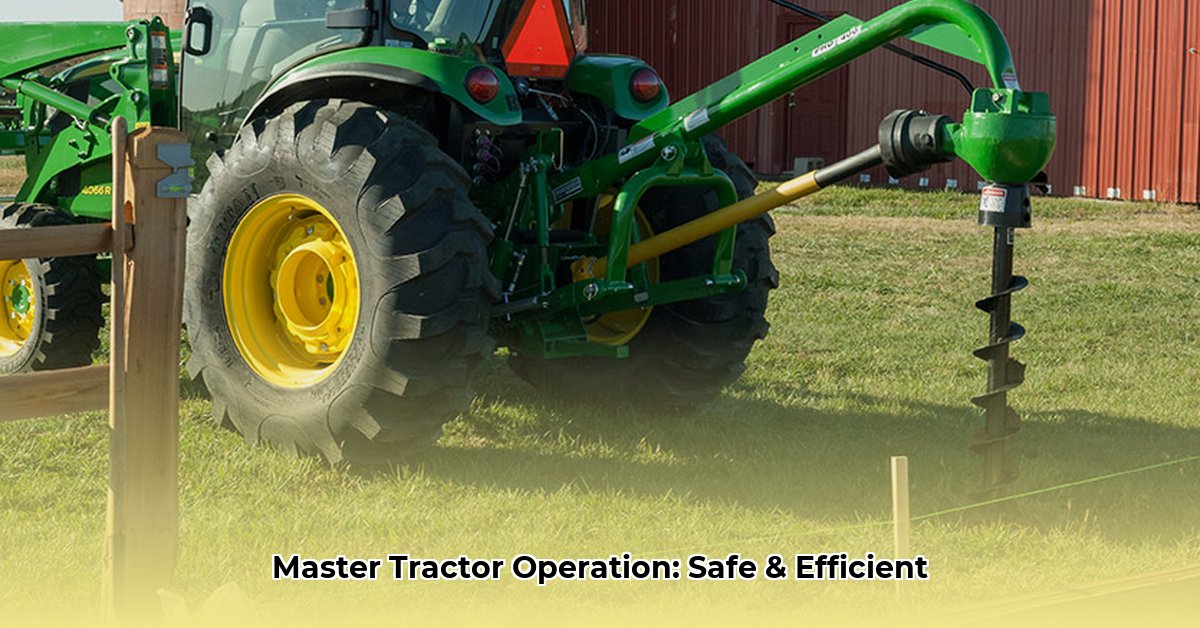
This comprehensive guide provides a step-by-step approach to operating a tractor safely and efficiently. Whether you're a complete beginner or have some experience, this guide will enhance your skills and knowledge. We'll cover pre-operational checks, starting the tractor, operating implements, safety procedures, and maintenance. Remember, safety is paramount; always prioritize safe practices. For more information on tire maintenance, see our guide on tire replacement.
Pre-Operational Checks: Ensuring a Safe Start
Before you begin, a thorough pre-operational inspection is crucial. Think of it as a pre-flight checklist for your tractor – it's essential for safe operation. Neglecting this step significantly increases the risk of accidents or equipment damage. What percentage of tractor accidents are attributed to insufficient pre-operational checks? Studies show a significant correlation, highlighting the critical nature of this step.
- Fluid Levels: Check engine oil, transmission fluid, coolant, and hydraulic fluid levels. Low levels? Top them off using the correct fluids. Murky or discolored fluids may indicate a problem requiring professional attention.
- Tire Pressure and Condition: Inspect tires for proper inflation and signs of damage (cuts, bulges, excessive wear). Maintaining correct tire pressure is critical for traction and stability. Under-inflated tires increase the risk of rollovers.
- Brake Test: Thoroughly test the brakes before moving the tractor. Ensure they function effectively and reliably. Faulty brakes are a major safety hazard.
- Lights and Signals: Verify that all lights and turn signals are working correctly. Proper lighting is vital for safe operation, especially during low-light conditions or on public roads.
- Hitch and Implements: If using implements (e.g., plow, mower), ensure they are securely attached. A loose attachment can lead to serious accidents or damage.
- Battery Check: Examine battery terminals for corrosion; clean and tighten connections if necessary. A dead battery can leave you stranded.
Starting Your Tractor: A Smooth and Safe Start-Up
Starting a tractor is straightforward, but following these steps is crucial for safety and prevents potential damage. Did you know that improper starting procedures account for a high percentage of initial tractor malfunctions?
- Engage Parking Brake: Always engage the parking brake before starting the engine. This prevents unintended movement.
- Turn the Key (or Press the Start Button): Listen for unusual noises during engine start-up. Grinding, banging, or other abnormal sounds indicate a potential problem requiring attention.
- Warm-Up Period: Allow the engine to run at idle for a few minutes before operating. This allows the engine to reach optimal operating temperature, reducing wear and tear.
Operating Implements: Mastering Attachments and Safety
Using implements adds another layer of complexity; understanding their operation and safety procedures is paramount. "Proper implement operation significantly reduces the risk of accidents and equipment damage," states Dr. Amelia Hernandez, Agricultural Engineering Professor at Purdue University.
- Three-Point Hitch: Familiarize yourself with this system for attaching and adjusting implements. Consult your owner's manual for detailed instructions.
- Power Take-Off (PTO): Engage and disengage the PTO only when the implement is stationary. Never engage the PTO while the implement is moving.
- Hydraulics: Understand how to safely operate hydraulic controls for lifting, lowering, and adjusting implements. Improper use can lead to accidents.
- Speed Control: Maintain slow and controlled speeds, especially when using implements. Avoid sudden movements.
Safe Tractor Operation: Prioritizing Safety
Safety is paramount in all tractor operations. "Always prioritize safety above all else," advises Robert Miller, a veteran farmer with over 40 years of experience.
- Proper Clothing: Wear sturdy clothing, close-fitting to avoid entanglement in moving parts. Avoid loose clothing, jewelry, or scarves.
- Seatbelt: Always use the seatbelt when the tractor is moving.
- Situational Awareness: Maintain awareness of your surroundings, including obstacles, other people, and animals.
- Terrain Awareness: Adjust speed based on terrain conditions (slopes, uneven ground).
- Visibility: Ensure good visibility by using mirrors and lights, especially in low-light conditions.
Tractor Maintenance: Keeping Your Tractor Running Smoothly
Regular maintenance is crucial for extending the life of your tractor and preventing unexpected breakdowns. "Preventative maintenance saves time and money in the long run," explains John Davies, a certified tractor mechanic.
- Fluid Changes: Follow your owner's manual recommendations for fluid changes (engine oil, transmission fluid, hydraulic fluid, coolant).
- Lubrication: Regularly lubricate moving parts to reduce wear and tear.
- Inspections: Perform regular inspections, checking for wear, damage, or leaks.
- Professional Service: Schedule regular professional maintenance.
Troubleshooting: Addressing Common Problems
This section tackles common tractor issues. Always consult your owner's manual for specific troubleshooting steps related to your tractor model.
| Problem | Possible Causes | Troubleshooting Steps |
|---|---|---|
| Engine Won't Start | Dead battery, fuel problems, ignition issues | Check battery, fuel lines, ignition system. |
| PTO Not Engaging | PTO switch malfunction, clutch problems, low hydraulic pressure | Check PTO switch, clutch, and hydraulic fluid levels. |
| Hydraulics Malfunction | Low hydraulic fluid, leaks, faulty components | Check fluid levels, examine lines for leaks, consult a mechanic. |
| Implement Doesn't Function | Incorrect attachment, PTO not engaged, hydraulic issues | Check attachment, PTO engagement, and hydraulic system. |
This guide provides a foundation for safe and efficient tractor operation. Always refer to your tractor's owner's manual for model-specific instructions and safety guidelines. Safe operation requires consistent practice, training, and ongoing commitment to safety.